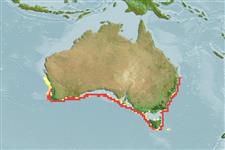Elasmobranchii (sharks and rays) >
Rajiformes (Skates and rays) >
Rajidae (Skates)
Etymology: Dipturus: Greek, di = two + Greek, pteryx = fin (Ref. 45335).
Eponymy: Dr Eugene Willis Gudger (1866–1956) was an associate in ichthyology at the AMNH, New York, which he joined (1919) and later became Curator of Fishes. [...] (Ref. 128868), visit book page.
More on author: Whitley.
Environment: milieu / climate zone / depth range / distribution range
Ecology
Marine; bathydemersal; depth range 160 - 765 m (Ref. 114953), usually 400 - 550 m (Ref. 6871). Temperate; 28°S - 44°S, 112°E - 155°E (Ref. 114953)
Indo-West Pacific: southern Australia, from Western Australia to New South Wales.
Length at first maturity / Size / Weight / Age
Maturity: Lm ?, range 127 - ? cm
Max length : 184 cm TL male/unsexed; (Ref. 114953)
Occur over soft bottoms of the continental slope (Ref. 7300, 75154). Mainly feeds on small bony fishes (Ref. 114953). Oviparous (Ref. 50449). Eggs have horn-like projections on the shell (Ref. 205); egg cases ca. 19 cm long (Ref. 114953). This species reaches maturity at ca. 13 years. Length of mature males at ca. 120 cm TL; young hatch at ca. 26 cm TL (Ref. 114953).
Life cycle and mating behavior
Maturity | Reproduction | Spawning | Eggs | Fecundity | Larvae
Oviparous, paired eggs are laid. Embryos feed solely on yolk (Ref. 50449).
McEachran, J.D. and K.A. Dunn, 1998. Phylogenetic analysis of skates, a morphologically conservative clade of elasmobranchs (Chondrichthyes: Rajidae). Copeia 1998(2):271-290. (Ref. 27314)
IUCN Red List Status (Ref. 130435: Version 2024-2)
Threat to humans
Harmless
Human uses
Tools
Special reports
Download XML
Internet sources
Estimates based on models
Preferred temperature (Ref.
123201): 7.8 - 10.8, mean 9.5 °C (based on 33 cells).
Phylogenetic diversity index (Ref.
82804): PD
50 = 0.5000 [Uniqueness, from 0.5 = low to 2.0 = high].
Bayesian length-weight: a=0.00282 (0.00131 - 0.00604), b=3.25 (3.08 - 3.42), in cm total length, based on LWR estimates for this Genus-body shape (Ref.
93245).
Trophic level (Ref.
69278): 4.0 ±0.6 se; based on size and trophs of closest relatives
Resilience (Ref.
120179): Low, minimum population doubling time 4.5 - 14 years (Assuming fecundity<100).
Fishing Vulnerability (Ref.
59153): Very high vulnerability (90 of 100).
